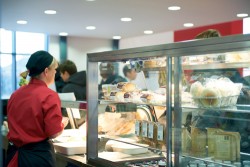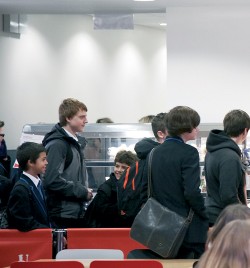In 2009, in response to increasing pressure on schools to collect and monitor data regarding the take up and nutritional quality of their midday meals, the Schools Food Trust commissioned a report looking into cashless catering. Around half the schools surveyed had already begun operating such a system. Those establishments that had not chosen to take this route indicated that the main constraints were the initial budgetary outlay required; a lack of good quality information about various systems available; and concerns about what might happen in the event of a technical failure. However, the majority of schools where a system was already up and running indicated that they would definitely recommend it to others, and highlighted a number of clear benefits for parents, pupils and staff.

In this sense, of course, it could be argued that removing the need for young people to handle, manage and budget with hard cash is potentially missing an opportunity to prepare them for the financial pressures of functioning as an adult ("if you choose to spend your lunch budget on magazines or chocolate, then you'll just have to deal with the consequent hunger pangs by mid-afternoon") – however, the truth is that society itself is becoming increasingly reliant on 'cashless' systems and so, as long as students are encouraged to understand the process by which it works, a money-free catering operation can be seen as a useful and realistic representation of the bigger picture. And given the rather shocking state of our nation's eating habits generally, most people would probably accept that a little 'nannying' of our teenagers is worth it, if it leads to better learning in the short-term – research shows that skipping lunch has a dramatic effect on pupils' ability to concentrate towards the end of the school day – and improved overall health in the longer term.
As part of its commitment to nurturing all aspects of student well being, Harwich and Dovercourt High School, Essex – which is located in one of the most deprived catchment areas in the country – opened its brand new, state of the art canteen facility, the Lighthouse, in 2010. A slight improvement in the take-up of school meals followed, but it was the introduction of WisePay, a cashless system that enables parents and carers to pay online for school meals, as well as trips, visits, and even uniform, in January of this year that has led to a real shift in culture, especially in terms of parents finally applying for the free school meals to which their children are entitled, as they can now do so without distinguishing them amongst their peers. "As a parent, I find it so easy," observes Johanna Sturges, who has a son and a daughter at the school. "I can top up their cards online, so there's no more frantic searching for change at five to eight in the morning. I simply log on, choose how much I want to pay, enter my card details and within 15 minutes, the credit is loaded onto the individual cards. An added bonus is the option to review what the children are buying; the school sets a daily limit for how much they can spend (to prevent them buying lunch for the whole class!) and then everything they purchase is registered to my account so that I can see what they brought, at what time for any given day. I don't need to worry about them losing their money – if they misplace their card I just need to have it replaced and the balance will still be there. As a governor of the school I am proud that we have advanced to using a cashless catering system, I feel that it is the future for most schools and it puts us ahead of the rest. It would be great if at some point we could incorporate an app that would enable parents to access the system and upload credit via our phones."
And the students? Well, Johanna's daughter, Jemma, in Y11, is totally on board with the cashless system, and she says that her friends are, too. "I do carry money outside school at the moment, as I can't have a debit card until I'm 16," she points out, "but I've got used to banking and shopping online, and it's so much easier than lugging cash around. Having the cashless system for the canteen is great – apart from anything else, it means that you get your food quicker, as you don't have to wait for everyone to sort out change at the till!"

Case study
Hinchingbrooke School, Huntingdon in Cambridgeshire, is a large establishment, with 1930 students (although this does include more than 440 sixth-formers); a cashless system for the canteen was introduced in the summer of 2011.
"The introduction of a cashless system was a fairly natural evolution for us," explains communications manager Sheila Wotherspoon. "Hinchingbrooke is constantly developing, and we are always looking for new ways in which we can improve the service we deliver for pupils and parents, and make our operation run more smoothly, conveniently and cost-effectively for everyone. We already had ParentMail set up, and so it made sense that going cashless would be the next, progressive step.
After speaking to a range of companies, we settled on MH Systems, who were able to set up an infrastructure that would work with ParentMail's +Pay, as well as incorporating top up machines that take cash. This means that parents can be reasonably flexible in how they use the system, either giving their children a set amount of money to bring in to school and load weekly or monthly, or topping up their accounts online. Pupils who are on free school meals have credit automatically added to their accounts daily, and of course, this is one of the major advantages of the cashless system, as it means there is absolutely no way to distinguish them from their peers at the checkout.
Instead of some kind of card or token, which could easily be lost, we have a biometric system of student recognition, which works using finger imaging. We've had very few problems with it so far – there are always catering staff members available at the checkout in case of any issues, and there are two or three points around the school where pupils can go and redo their finger images if necessary. With a very small number of exceptions, parents and pupils alike seem to be comfortable with the technology, and we may be able to find other ways to use it in the future (we already encourage parents to use ParentMail to pay for trips and visits).
We are a large school, and in these pressing times, when we have to look more critically than ever at budgets, anything that promises an increase in efficiency has got to be worth considering. It's very early days with the cashless catering system, but we definitely see it developing, and saving us a considerable amount in admin costs in the long term. Last year the take up amongst our new Y7 parents was 95%, and it seems reasonable to expect that this culture shift will continue, with an associated set of advantages: less cash on school premises, with fewer incidences of money being lost or taken; more parental awareness of what their children are eating (they can track this information online), and more parental control in terms of how much is spent and an increase in the take-up of school meals.
We would definitely recommend cashless catering to other schools. There are plenty of excellent companies out there, so it's wise to shop around to see which is best able to meet the specific needs of your staff, pupils and parents, and ultimately offer you a genuine reduction in overheads and admin. As with all innovations, it's essential to keep communication with parents strong throughout the transition – if you explain to them what you are doing and why, and get them on board from the start, then the whole process becomes much easier."

Parent power
Over 10,000 parents responded to a recent LACA/ParentPay school meals survey. The research, published as part of LACA's National School Meals Week, revealed parents' genuine concerns about money being spent on the way to school, showing that an overwhelming 94% didn't want cash spent on confectionary before young people reached the classroom. 80% wanted more information about what their children eat – and, perhaps most worryingly, 49% did not take up free school meals due to social stigma concerns. The 2012 research will be published at the start of NSMW on November 5th 2012. To download the report and find out how online payments integrated with cashless catering systems can solve these issues, go to www.parentpay.com.











“Apart from anything else, it means you get your food quicker, as you don’t have to wait for everyone to sort out change at the till!”